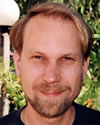Dr. Jan Witting
Faculty, Sea Education Association
Woods Hole, Massachusetts, USA

Jan Witting is a member of the Oceanography faculty at Sea Education Association. He received his BS and his PhD in Marine Biology at Northeastern University, with a research focus on coral feeding ecology, an important link in benthic-pelagic coupling in tropical waters. Jan’s background includes designing and constructing autonomous underwater vehicles, teaching at the Discovery Bay Marine Lab in Jamaica and at Northeastern University, and extensive participation in research cruises in the Atlantic Ocean and Caribbean Sea. Also an avid sailor (he owns a 45’ ketch), Jan brings to his students his passion for science and sailing.
Selected Publications:
Witting, J.H. and K. Safak. SMA actuators applied to biomimetic underwater robots. In: Neurotechnology for biomimetic robots. MIT press. In press.
Sebens, K.P., J.H. Witting and B. Helmuth, 1997. Effects of water flow and branch spacing on particle capture by the reef coral Madracis mirabilis (Duchassaing and Michelotti). Journal of Experimental Marine Biology and Ecology 211: 1-28.
Sebens, K.P., E.J. Maney and J.H. Witting, 1992. A portable, diver-operated plankton sampler for near substratum use. Proceedings of the American Academy of Underwaters Sciences twelth annual scientific diving symposium. L.B. Cahoon, Ed. 167-172.
Witting, J.H., and K.P. Sebens. The role of zooplankton capture in six Caribbean sclearctinian corals: in situ evidence that heterotrophy limits coral growth. In preparation for Ecology.
Witting, J.H. and K.P. Sebens. In situ measurement of suspension feeding by the Caribbean scleractinian corals Agaricia agaricites, Montastrea faveolata and Madracis mirabilis on nano- and microplankton size particles. In preparation for Coral Reefs.
Witting, J.H. Water flow mediated differences in the size of captured particles in five Caribbean scleractinian corals: particle capture strategies change with coral morphology. In preparation for Journal of Experimental Marine Biology and Ecology.
